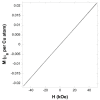Quantum Spin-1/2 Dimers in a Low-Dimensional Tetrabromocuprate Magnet
- PMID: 35357728
- PMCID: PMC9323490
- DOI: 10.1002/chem.202200855
Quantum Spin-1/2 Dimers in a Low-Dimensional Tetrabromocuprate Magnet
Abstract
This work describes a homometallic spin- tetrabromocuprate adopting a bilayer structure. Magnetic-susceptibility measurements show a broad maximum centred near 70 K, with fits to this data using a Heisenberg model consistent with strong antiferromagnetic coupling between neighbouring copper atoms in different layers of the bilayer. There are further weak intralayer ferromagnetic interactions between copper cations in neighbouring dimers. First-principles calculations are consistent with this, but suggest there is only significant magnetic coupling within one direction of a layer; this would suggest the presence of a spin ladder within the bilayer with antiferromagnetic rung and weaker ferromagnetic rail couplings.
Keywords: X-ray diffraction; cuprates; density functional calculations; halides; magnetic properties.
© 2022 The Authors. Chemistry - A European Journal published by Wiley-VCH GmbH.
Conflict of interest statement
The authors declare no conflict of interest.
Figures




References
-
- Steiner M., Villain J., Windsor C. G., Adv. Phys. 1976, 25, 87–209.
-
- Mikeska H.-J., Steiner M., Adv. Phys. 1991, 40, 191–356.
-
- Sahling S., Remenyi G., Paulsen C., Monceau P., Saligrama V., Marin C., Revcolevschi A., Regnault L. P., Raymond S., Lorenzo J. E., Nat. Phys. 2015, 11, 255–260.
-
- Kim B. J., Koh H., Rotenberg E., Oh S.-J., Eisaki H., Motoyama N., Uchida S., Tohyama T., Maekawa S., Shen Z.-X., Kim C., Nat. Phys. 2006, 2, 397–401.
-
- Wu L. S., Gannon W. J., Zaliznyak I. A., Tsvelik A. M., Brockmann M., Caux J.-S., Kim M. S., Qiu Y., Copley J. R. D., Ehlers G., Podlesnyak A., Aronson M. C., Science 2016, 352, 1206–1210. - PubMed
Grants and funding
LinkOut - more resources
Full Text Sources

